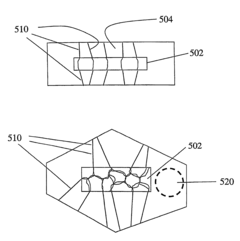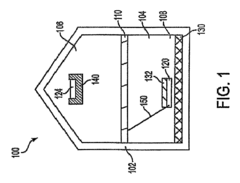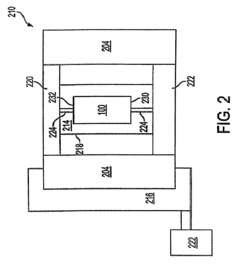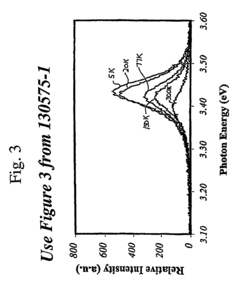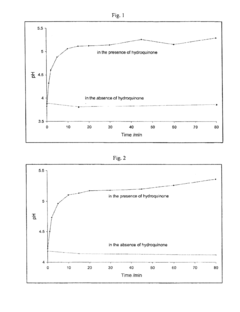How to Differentiate Lithium Nitride Effects in Variable Applications
AUG 28, 20259 MIN READ
Generate Your Research Report Instantly with AI Agent
Patsnap Eureka helps you evaluate technical feasibility & market potential.
Lithium Nitride Technology Background and Objectives
Lithium nitride (Li₃N) has emerged as a significant material in various technological applications over the past several decades. Initially discovered in the late 19th century, this compound remained primarily of academic interest until the 1980s when researchers began exploring its unique properties for energy storage applications. The distinctive ionic conductivity characteristics of lithium nitride, particularly its ability to facilitate lithium ion transport, positioned it as a promising material for battery technology development.
The evolution of lithium nitride research has accelerated dramatically in the past decade, driven by increasing demands for advanced energy storage solutions and the global push toward electrification. This compound's versatility extends beyond batteries to catalysis, hydrogen storage systems, and semiconductor applications, creating a complex technological landscape that necessitates careful differentiation of its effects across these varied implementations.
Current technological objectives in lithium nitride research center on understanding and optimizing its behavior in different application environments. This includes enhancing its stability in atmospheric conditions, improving its ionic conductivity for battery applications, and developing scalable synthesis methods that maintain precise control over material properties. The differentiation of lithium nitride effects across variable applications represents a critical challenge that must be addressed to fully leverage its potential.
From a historical perspective, lithium nitride research has progressed through several distinct phases: initial discovery and characterization, theoretical modeling of its unique crystal structure, experimental validation of its ionic conductivity properties, and most recently, application-specific optimization. Each phase has contributed valuable insights into how this material behaves under different conditions and in various technological contexts.
The current technological landscape presents both opportunities and challenges for lithium nitride implementation. While its theoretical properties make it highly attractive for numerous applications, practical limitations related to synthesis, stability, and performance variability have hindered widespread commercial adoption. Understanding how to differentiate and control lithium nitride effects across applications requires a multidisciplinary approach combining materials science, electrochemistry, and engineering perspectives.
Looking forward, the technological trajectory for lithium nitride appears focused on developing application-specific formulations and processing techniques that can reliably produce desired properties for targeted use cases. This represents a shift from earlier research paradigms that sought universal understanding toward more specialized approaches that acknowledge the context-dependent nature of lithium nitride behavior.
The evolution of lithium nitride research has accelerated dramatically in the past decade, driven by increasing demands for advanced energy storage solutions and the global push toward electrification. This compound's versatility extends beyond batteries to catalysis, hydrogen storage systems, and semiconductor applications, creating a complex technological landscape that necessitates careful differentiation of its effects across these varied implementations.
Current technological objectives in lithium nitride research center on understanding and optimizing its behavior in different application environments. This includes enhancing its stability in atmospheric conditions, improving its ionic conductivity for battery applications, and developing scalable synthesis methods that maintain precise control over material properties. The differentiation of lithium nitride effects across variable applications represents a critical challenge that must be addressed to fully leverage its potential.
From a historical perspective, lithium nitride research has progressed through several distinct phases: initial discovery and characterization, theoretical modeling of its unique crystal structure, experimental validation of its ionic conductivity properties, and most recently, application-specific optimization. Each phase has contributed valuable insights into how this material behaves under different conditions and in various technological contexts.
The current technological landscape presents both opportunities and challenges for lithium nitride implementation. While its theoretical properties make it highly attractive for numerous applications, practical limitations related to synthesis, stability, and performance variability have hindered widespread commercial adoption. Understanding how to differentiate and control lithium nitride effects across applications requires a multidisciplinary approach combining materials science, electrochemistry, and engineering perspectives.
Looking forward, the technological trajectory for lithium nitride appears focused on developing application-specific formulations and processing techniques that can reliably produce desired properties for targeted use cases. This represents a shift from earlier research paradigms that sought universal understanding toward more specialized approaches that acknowledge the context-dependent nature of lithium nitride behavior.
Market Analysis for Lithium Nitride Applications
The global lithium nitride market is experiencing significant growth, driven primarily by the expanding applications in energy storage systems, particularly lithium-ion batteries. Current market valuation stands at approximately $320 million, with projections indicating a compound annual growth rate of 8.7% through 2030, potentially reaching $650 million by the end of the decade.
The energy storage sector represents the largest application segment, accounting for nearly 45% of the total market share. This dominance is attributed to lithium nitride's exceptional ionic conductivity properties, which enhance battery performance and safety profiles. The automotive industry, especially electric vehicles, constitutes the fastest-growing segment with a growth rate of 12.3% annually, as manufacturers seek advanced materials to improve battery efficiency and longevity.
Geographically, Asia-Pacific leads the market with over 60% share, primarily due to the concentration of battery manufacturing facilities in China, Japan, and South Korea. North America follows with approximately 20% market share, driven by increasing investments in renewable energy storage solutions and electric vehicle production.
The electronics industry represents another significant application area, where lithium nitride is utilized in semiconductor manufacturing and as a component in specialized electronic devices. This segment currently holds about 15% of the market share but is expected to grow as miniaturization trends continue in consumer electronics.
Emerging applications in hydrogen storage systems and catalytic processes are creating new market opportunities, albeit currently representing less than 5% of total demand. Research indicates these niche applications could expand significantly as hydrogen economy initiatives gain momentum globally.
Market challenges include supply chain vulnerabilities, as lithium nitride production is concentrated among a limited number of manufacturers. Price volatility remains a concern, with raw material costs fluctuating by up to 30% in recent years. Additionally, technical challenges in scaling production while maintaining quality consistency have restricted market expansion in certain high-precision applications.
Customer segmentation analysis reveals that large-scale battery manufacturers constitute 55% of end-users, followed by automotive companies (25%), electronics manufacturers (15%), and research institutions (5%). This distribution highlights the material's critical importance in energy storage technologies while indicating potential for diversification into other industrial applications.
The energy storage sector represents the largest application segment, accounting for nearly 45% of the total market share. This dominance is attributed to lithium nitride's exceptional ionic conductivity properties, which enhance battery performance and safety profiles. The automotive industry, especially electric vehicles, constitutes the fastest-growing segment with a growth rate of 12.3% annually, as manufacturers seek advanced materials to improve battery efficiency and longevity.
Geographically, Asia-Pacific leads the market with over 60% share, primarily due to the concentration of battery manufacturing facilities in China, Japan, and South Korea. North America follows with approximately 20% market share, driven by increasing investments in renewable energy storage solutions and electric vehicle production.
The electronics industry represents another significant application area, where lithium nitride is utilized in semiconductor manufacturing and as a component in specialized electronic devices. This segment currently holds about 15% of the market share but is expected to grow as miniaturization trends continue in consumer electronics.
Emerging applications in hydrogen storage systems and catalytic processes are creating new market opportunities, albeit currently representing less than 5% of total demand. Research indicates these niche applications could expand significantly as hydrogen economy initiatives gain momentum globally.
Market challenges include supply chain vulnerabilities, as lithium nitride production is concentrated among a limited number of manufacturers. Price volatility remains a concern, with raw material costs fluctuating by up to 30% in recent years. Additionally, technical challenges in scaling production while maintaining quality consistency have restricted market expansion in certain high-precision applications.
Customer segmentation analysis reveals that large-scale battery manufacturers constitute 55% of end-users, followed by automotive companies (25%), electronics manufacturers (15%), and research institutions (5%). This distribution highlights the material's critical importance in energy storage technologies while indicating potential for diversification into other industrial applications.
Current Technical Challenges in Lithium Nitride Implementation
Despite the promising properties of lithium nitride (Li3N) for various applications, several significant technical challenges currently impede its widespread implementation. The primary obstacle remains its high reactivity with moisture and air, which necessitates stringent handling protocols in controlled environments. This extreme sensitivity to environmental conditions substantially increases manufacturing costs and complicates integration into commercial products, limiting its practical applications outside laboratory settings.
The thermal stability of lithium nitride presents another critical challenge, particularly in high-temperature applications. While Li3N exhibits excellent ionic conductivity at room temperature, its performance characteristics change dramatically at elevated temperatures, with phase transitions occurring around 815K. These transitions alter its electrical and mechanical properties, creating reliability concerns for applications requiring consistent performance across varying thermal conditions.
Scalable and cost-effective production methods represent a significant hurdle in lithium nitride implementation. Current synthesis techniques often yield inconsistent product quality with variable stoichiometry and impurity levels. The lack of standardized manufacturing processes capable of producing high-purity Li3N at industrial scales severely constrains its commercial viability, particularly for mass-market applications in energy storage and electronics.
Application-specific optimization of lithium nitride properties remains underdeveloped. Different applications—whether in batteries, hydrogen storage systems, or semiconductor devices—require tailored material characteristics. The current understanding of how to precisely engineer Li3N properties for specific use cases is limited, creating a knowledge gap between fundamental research and practical implementation.
Interface compatibility issues further complicate lithium nitride integration into existing systems. Chemical and electrochemical interactions at material interfaces often lead to degradation or performance losses over time. This is particularly problematic in battery applications, where Li3N must maintain stable interfaces with electrodes and electrolytes throughout numerous charge-discharge cycles.
Characterization and testing methodologies for lithium nitride-based systems lack standardization, making performance comparisons across different research efforts challenging. The absence of universally accepted testing protocols hampers technology transfer from research laboratories to industrial applications and slows the overall pace of innovation in this field.
Regulatory and safety concerns regarding lithium nitride handling, transportation, and disposal present additional implementation barriers. The reactive nature of Li3N raises legitimate safety questions that must be addressed through comprehensive risk assessments and mitigation strategies before widespread commercial adoption can occur.
The thermal stability of lithium nitride presents another critical challenge, particularly in high-temperature applications. While Li3N exhibits excellent ionic conductivity at room temperature, its performance characteristics change dramatically at elevated temperatures, with phase transitions occurring around 815K. These transitions alter its electrical and mechanical properties, creating reliability concerns for applications requiring consistent performance across varying thermal conditions.
Scalable and cost-effective production methods represent a significant hurdle in lithium nitride implementation. Current synthesis techniques often yield inconsistent product quality with variable stoichiometry and impurity levels. The lack of standardized manufacturing processes capable of producing high-purity Li3N at industrial scales severely constrains its commercial viability, particularly for mass-market applications in energy storage and electronics.
Application-specific optimization of lithium nitride properties remains underdeveloped. Different applications—whether in batteries, hydrogen storage systems, or semiconductor devices—require tailored material characteristics. The current understanding of how to precisely engineer Li3N properties for specific use cases is limited, creating a knowledge gap between fundamental research and practical implementation.
Interface compatibility issues further complicate lithium nitride integration into existing systems. Chemical and electrochemical interactions at material interfaces often lead to degradation or performance losses over time. This is particularly problematic in battery applications, where Li3N must maintain stable interfaces with electrodes and electrolytes throughout numerous charge-discharge cycles.
Characterization and testing methodologies for lithium nitride-based systems lack standardization, making performance comparisons across different research efforts challenging. The absence of universally accepted testing protocols hampers technology transfer from research laboratories to industrial applications and slows the overall pace of innovation in this field.
Regulatory and safety concerns regarding lithium nitride handling, transportation, and disposal present additional implementation barriers. The reactive nature of Li3N raises legitimate safety questions that must be addressed through comprehensive risk assessments and mitigation strategies before widespread commercial adoption can occur.
Current Methodologies for Lithium Nitride Differentiation
01 Lithium nitride in battery technology
Lithium nitride serves as an important material in battery technology, particularly in lithium-ion batteries. It can function as a solid electrolyte material, offering improved ionic conductivity and stability. When incorporated into battery systems, lithium nitride can enhance energy density, cycle life, and safety performance. It also facilitates faster lithium-ion transport, which is crucial for high-performance energy storage applications.- Lithium nitride in battery applications: Lithium nitride serves as an important material in battery technology, particularly for lithium-ion batteries. It can be used as a solid electrolyte material, offering high ionic conductivity and stability. When incorporated into battery systems, lithium nitride can enhance energy density, improve cycling performance, and increase battery lifespan. It also contributes to the development of all-solid-state batteries by providing efficient lithium ion transport pathways.
- Semiconductor and electronic device applications: Lithium nitride has significant effects in semiconductor manufacturing and electronic devices. It can be used as a dopant or buffer layer in semiconductor fabrication, affecting the electronic properties of materials. In electronic devices, lithium nitride films can serve as protective layers or functional components. The material's unique electronic properties make it valuable for specialized electronic applications, including in transistors, diodes, and integrated circuits.
- Hydrogen storage and energy applications: Lithium nitride demonstrates remarkable effects in hydrogen storage systems. It can absorb and release hydrogen under specific conditions, making it a potential material for hydrogen storage applications. The material undergoes reversible reactions with hydrogen, forming lithium imide and lithium amide compounds. This property is valuable for clean energy applications, fuel cells, and hydrogen-based energy storage systems, contributing to sustainable energy solutions.
- Coating and surface treatment effects: Lithium nitride can be applied as a coating or surface treatment material with various beneficial effects. When used as a thin film coating, it can provide protection against corrosion, oxidation, and wear. The material's properties allow for enhanced surface hardness and durability of treated components. Additionally, lithium nitride coatings can modify surface properties for specific applications, including optical, thermal, and tribological enhancements.
- Catalytic and chemical reaction effects: Lithium nitride exhibits catalytic effects in various chemical reactions. It can serve as a catalyst or promoter in organic synthesis, ammonia production, and other chemical processes. The material's unique electronic structure and nitrogen-rich composition enable it to facilitate certain reaction pathways. In chemical applications, lithium nitride can enhance reaction rates, improve selectivity, and enable reactions under milder conditions, making it valuable for industrial chemical processes.
02 Semiconductor and electronic applications
Lithium nitride has significant effects in semiconductor manufacturing and electronic applications. It can be used as a dopant or thin film material in semiconductor devices, affecting electrical conductivity and device performance. The material's unique properties allow for the creation of specialized electronic components with enhanced characteristics. Lithium nitride films can be deposited using various techniques to create functional layers in electronic devices.Expand Specific Solutions03 Hydrogen storage and energy applications
Lithium nitride demonstrates remarkable effects in hydrogen storage systems and related energy applications. It can absorb and release hydrogen under specific conditions, making it valuable for hydrogen storage technologies. The material's interaction with hydrogen is reversible, allowing for cyclical use in energy storage systems. This property makes lithium nitride a candidate material for clean energy applications and hydrogen-based energy systems.Expand Specific Solutions04 Catalytic and chemical reaction effects
Lithium nitride exhibits catalytic effects in various chemical reactions and processes. It can facilitate certain chemical transformations, acting as a catalyst or reaction promoter. The material's surface properties and reactivity make it useful in specialized chemical synthesis applications. When used in catalytic systems, lithium nitride can improve reaction efficiency, selectivity, and yield of desired products.Expand Specific Solutions05 Advanced materials synthesis and modification
Lithium nitride plays a significant role in the synthesis and modification of advanced materials. It can be used as a precursor for creating complex nitride compounds with specialized properties. The material enables the development of novel composites with enhanced mechanical, thermal, or electrical characteristics. Lithium nitride's reactivity allows for the creation of new material structures through various processing techniques, contributing to materials science advancements.Expand Specific Solutions
Key Industry Players in Lithium Nitride Research
Lithium nitride technology is currently in an early growth phase, with the market expanding due to increasing applications in energy storage, semiconductor manufacturing, and advanced materials. The global market size is projected to grow significantly as lithium-based technologies gain prominence in renewable energy and electric vehicle sectors. Technologically, the field shows varying maturity levels across applications, with companies like LG Energy Solution and CATL leading commercial deployment in battery applications, while PolyPlus Battery and Semiconductor Energy Laboratory focus on cutting-edge research for next-generation lithium nitride implementations. Academic-industry partnerships involving institutions like Huazhong University and companies such as EVE Energy are accelerating innovation, particularly in improving stability, conductivity, and manufacturing scalability of lithium nitride compounds for diverse industrial applications.
LG Energy Solution Ltd.
Technical Solution: LG Energy Solution has developed a sophisticated lithium nitride (Li3N) interface engineering approach for advanced lithium metal batteries. Their technology utilizes a controlled in-situ formation of lithium nitride layers at the electrode-electrolyte interface to enhance battery performance across various applications. The company's proprietary process involves nitrogen-enriched electrolyte additives that selectively react with lithium metal surfaces to form a protective Li3N-rich solid electrolyte interphase (SEI) with tunable thickness and composition. This approach allows for application-specific optimization of the Li3N layer properties. For high-energy density applications, LG Energy Solution creates thinner (50-100 nm) Li3N layers that maximize energy density while providing sufficient protection. For high-power applications, they engineer thicker (200-300 nm) Li3N layers with gradient structures to withstand mechanical stress during rapid charging. Their research has demonstrated that optimized Li3N interfaces can enable lithium metal batteries with energy densities exceeding 400 Wh/kg while maintaining 80% capacity retention after 500 cycles.
Strengths: Tunable Li3N interface properties for different applications; in-situ formation process compatible with existing manufacturing; excellent ionic conductivity while blocking electron transfer; effective dendrite suppression. Weaknesses: Sensitivity to electrolyte composition and impurities; potential for non-uniform Li3N formation across large-format cells; performance degradation at extreme temperatures; requires precise control of formation conditions.
PolyPlus Battery Co., Inc.
Technical Solution: PolyPlus has developed a proprietary lithium nitride-based protected lithium electrode (PLE) technology that forms a solid electrolyte interface on lithium metal anodes. Their approach utilizes a thin lithium nitride (Li3N) layer as a protective coating that prevents direct contact between lithium metal and liquid electrolytes while allowing efficient lithium-ion transport. This technology enables the creation of lithium-water, lithium-air, and lithium-sulfur batteries with significantly higher energy densities than conventional lithium-ion batteries. The lithium nitride layer is formed through a controlled reaction between lithium metal and nitrogen gas, creating a self-limiting protective film that is both ionically conductive and chemically stable in various electrolyte environments. PolyPlus has demonstrated that their Li3N-based PLE can effectively prevent dendrite formation and parasitic reactions that typically plague lithium metal batteries.
Strengths: Superior protection against dendrite formation; enables use of lithium metal anodes with aggressive cathode materials; significantly increases energy density potential; extends cycle life in challenging battery chemistries. Weaknesses: Manufacturing complexity of uniform Li3N layers; potential for mechanical stress during cycling; higher production costs compared to conventional electrode technologies.
Critical Patents and Research on Lithium Nitride Effects
Crystalline composition, wafer, and semi-conductor structure
PatentInactiveUS7638815B2
Innovation
- A crystalline composition of gallium nitride with specific characteristics, including gallium vacancies passivated by hydrogen, is developed, which is free of magnesium and has a low dislocation density, allowing for the growth of large-area, low-defect gallium nitride crystals using temperature gradient recrystallization in a superheated fluid solvent.
Nitric oxide-generating skin dressings
PatentActiveUS20150030702A1
Innovation
- A skin dressing comprising a source of protons and a nitrite salt with a non-thiol reductant, which generates nitric oxide by increasing the pH from an acidic value to a more neutral value, utilizing a self-regulating mechanism to maintain a mild pH environment and avoid nitrogen dioxide production.
Safety and Handling Protocols for Lithium Nitride
The safe handling of lithium nitride (Li₃N) is paramount due to its high reactivity with moisture and air, which can lead to the formation of ammonia gas and lithium hydroxide. Proper safety protocols must be established and strictly followed to prevent accidents and ensure worker protection. Personnel handling lithium nitride should wear appropriate personal protective equipment (PPE), including chemical-resistant gloves, safety goggles, lab coats, and in some cases, respiratory protection depending on the quantity being handled and the ventilation conditions of the workspace.
Storage considerations for lithium nitride are critical to maintaining its stability and preventing hazardous reactions. The compound must be stored in airtight containers under an inert atmosphere, typically argon or nitrogen, to prevent contact with moisture. Storage areas should be cool, dry, and well-ventilated, away from incompatible materials such as water, acids, and oxidizing agents. Regular inspections of storage containers for integrity and proper sealing are essential to prevent degradation of the material.
Emergency response procedures for lithium nitride incidents should be clearly documented and communicated to all personnel working with or near the compound. These procedures should include specific steps for addressing spills, fires, and exposure incidents. For spills, the area should be evacuated, and only trained personnel with appropriate PPE should perform cleanup, using dry methods to avoid introducing moisture. Fire response should account for lithium nitride's potential to release ammonia gas when heated.
Training programs for personnel working with lithium nitride should be comprehensive and include both theoretical knowledge and practical skills. Topics should cover the chemical properties of lithium nitride, recognition of hazards, proper handling techniques, storage requirements, emergency procedures, and the correct use of PPE. Regular refresher training sessions should be conducted to ensure that knowledge remains current and practices are consistent with the latest safety standards.
Waste disposal of lithium nitride requires special attention due to its reactivity. Unused or waste material should be treated as hazardous waste and disposed of according to local regulations. Controlled decomposition under professional supervision may be necessary, typically involving gradual exposure to moisture in a controlled environment to convert the nitride to less reactive compounds before final disposal.
Monitoring and documentation systems should be implemented to track the use, storage, and disposal of lithium nitride. Regular audits of safety practices and compliance with handling protocols can help identify areas for improvement and ensure that safety standards are maintained over time. Documentation should include safety data sheets, training records, incident reports, and inventory logs.
Storage considerations for lithium nitride are critical to maintaining its stability and preventing hazardous reactions. The compound must be stored in airtight containers under an inert atmosphere, typically argon or nitrogen, to prevent contact with moisture. Storage areas should be cool, dry, and well-ventilated, away from incompatible materials such as water, acids, and oxidizing agents. Regular inspections of storage containers for integrity and proper sealing are essential to prevent degradation of the material.
Emergency response procedures for lithium nitride incidents should be clearly documented and communicated to all personnel working with or near the compound. These procedures should include specific steps for addressing spills, fires, and exposure incidents. For spills, the area should be evacuated, and only trained personnel with appropriate PPE should perform cleanup, using dry methods to avoid introducing moisture. Fire response should account for lithium nitride's potential to release ammonia gas when heated.
Training programs for personnel working with lithium nitride should be comprehensive and include both theoretical knowledge and practical skills. Topics should cover the chemical properties of lithium nitride, recognition of hazards, proper handling techniques, storage requirements, emergency procedures, and the correct use of PPE. Regular refresher training sessions should be conducted to ensure that knowledge remains current and practices are consistent with the latest safety standards.
Waste disposal of lithium nitride requires special attention due to its reactivity. Unused or waste material should be treated as hazardous waste and disposed of according to local regulations. Controlled decomposition under professional supervision may be necessary, typically involving gradual exposure to moisture in a controlled environment to convert the nitride to less reactive compounds before final disposal.
Monitoring and documentation systems should be implemented to track the use, storage, and disposal of lithium nitride. Regular audits of safety practices and compliance with handling protocols can help identify areas for improvement and ensure that safety standards are maintained over time. Documentation should include safety data sheets, training records, incident reports, and inventory logs.
Environmental Impact Assessment of Lithium Nitride Usage
The environmental impact of lithium nitride usage requires comprehensive assessment due to its increasing applications across various industries. Lithium nitride (Li₃N) presents both environmental challenges and benefits that must be carefully evaluated to ensure sustainable implementation in different application contexts.
When used in hydrogen storage systems, lithium nitride demonstrates significant environmental advantages compared to conventional fossil fuel technologies. The compound facilitates clean energy storage with minimal direct emissions during operation. However, the extraction of lithium for Li₃N production involves substantial land disturbance, water consumption, and potential contamination of water sources with chemicals used in the extraction process.
Manufacturing processes for lithium nitride typically require high temperatures and controlled atmospheres, resulting in considerable energy consumption. The carbon footprint associated with this energy usage varies significantly depending on the energy sources employed. Facilities utilizing renewable energy can substantially reduce the environmental impact compared to those relying on fossil fuels.
Waste management considerations are particularly important when assessing lithium nitride's environmental profile. The compound can react vigorously with water to produce lithium hydroxide and ammonia, potentially causing localized alkalinity increases and ammonia toxicity in aquatic ecosystems if improperly disposed. Proper containment systems and disposal protocols must be established to mitigate these risks.
Different applications of lithium nitride exhibit varying environmental footprints. In battery technologies, Li₃N contributes to extended battery life and improved performance, potentially reducing electronic waste. However, end-of-life management for lithium nitride-containing batteries presents recycling challenges that require specialized processes to prevent environmental contamination.
In semiconductor applications, the environmental impact primarily relates to the precision manufacturing processes and associated chemical usage. While quantities used are typically small, the high purity requirements may involve energy-intensive purification steps with corresponding environmental implications.
Regulatory frameworks for lithium nitride usage vary globally, with more stringent environmental protection measures in certain regions. These disparities create challenges for standardizing environmental impact assessments across international supply chains and applications.
Life cycle assessment (LCA) studies indicate that the environmental benefits of lithium nitride applications often outweigh the impacts when properly managed, particularly in renewable energy and energy storage contexts. However, these assessments must be application-specific to accurately reflect the environmental trade-offs involved in each use case.
When used in hydrogen storage systems, lithium nitride demonstrates significant environmental advantages compared to conventional fossil fuel technologies. The compound facilitates clean energy storage with minimal direct emissions during operation. However, the extraction of lithium for Li₃N production involves substantial land disturbance, water consumption, and potential contamination of water sources with chemicals used in the extraction process.
Manufacturing processes for lithium nitride typically require high temperatures and controlled atmospheres, resulting in considerable energy consumption. The carbon footprint associated with this energy usage varies significantly depending on the energy sources employed. Facilities utilizing renewable energy can substantially reduce the environmental impact compared to those relying on fossil fuels.
Waste management considerations are particularly important when assessing lithium nitride's environmental profile. The compound can react vigorously with water to produce lithium hydroxide and ammonia, potentially causing localized alkalinity increases and ammonia toxicity in aquatic ecosystems if improperly disposed. Proper containment systems and disposal protocols must be established to mitigate these risks.
Different applications of lithium nitride exhibit varying environmental footprints. In battery technologies, Li₃N contributes to extended battery life and improved performance, potentially reducing electronic waste. However, end-of-life management for lithium nitride-containing batteries presents recycling challenges that require specialized processes to prevent environmental contamination.
In semiconductor applications, the environmental impact primarily relates to the precision manufacturing processes and associated chemical usage. While quantities used are typically small, the high purity requirements may involve energy-intensive purification steps with corresponding environmental implications.
Regulatory frameworks for lithium nitride usage vary globally, with more stringent environmental protection measures in certain regions. These disparities create challenges for standardizing environmental impact assessments across international supply chains and applications.
Life cycle assessment (LCA) studies indicate that the environmental benefits of lithium nitride applications often outweigh the impacts when properly managed, particularly in renewable energy and energy storage contexts. However, these assessments must be application-specific to accurately reflect the environmental trade-offs involved in each use case.
Unlock deeper insights with Patsnap Eureka Quick Research — get a full tech report to explore trends and direct your research. Try now!
Generate Your Research Report Instantly with AI Agent
Supercharge your innovation with Patsnap Eureka AI Agent Platform!
